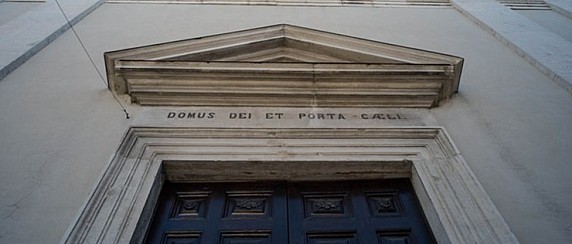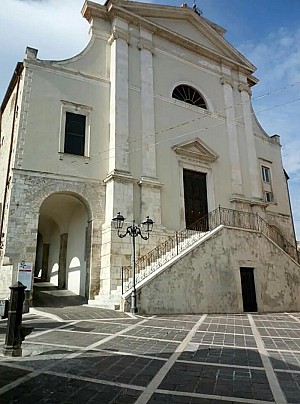Chiesa di Santa Maria Maggiore
Della Chiesa di Santa Maria Maggiore si faceva menzione nelle Rationes decimarum Italiae, pubblicate a cura di Pietro Sella, già nel 1324-1325. Secondo Mosè D’Amico, invece, la Chiesa sarebbe stata fondata nel 1445.
I principi Orsini costruirono la navata centrale e, come appendice a nord di essa, sorsero le tre cappelle di San Gilberto, San Giacinto e del Santissimo Sacramento.
All’incirca nel 1740 iniziò l’ampliamento con la terza navata (quella di sinistra) e la costruzione di due nuovi altari, quello del Santo Rosario e l’altro del Purgatorio, altari detti privilegiati perché vi era annessa un’indulgenza.Ultimata nel 1759, la navata è sorretta da quattro volte a crociera formanti il cosiddetto «Arco del Purgatorio», attraverso il quale si raggiunge il Castello.Altri interventi principali furono eseguiti nel 1869 (Abside) e intorno al 1850 (Costruzione del campanile).La Chiesa ha assunto un aspetto neoclassico nella facciata, ingentilita da una doppia scalinata (1906), mentre l’interno è il risultato del restauro eseguito dopo il terremoto del 1984.
I principi Orsini costruirono la navata centrale e, come appendice a nord di essa, sorsero le tre cappelle di San Gilberto, San Giacinto e del Santissimo Sacramento.
All’incirca nel 1740 iniziò l’ampliamento con la terza navata (quella di sinistra) e la costruzione di due nuovi altari, quello del Santo Rosario e l’altro del Purgatorio, altari detti privilegiati perché vi era annessa un’indulgenza.
Ultimata nel 1759, la navata è sorretta da quattro volte a crociera formanti il cosiddetto «Arco del Purgatorio», attraverso il quale si raggiunge il Castello.
Altri interventi principali furono eseguiti nel 1869 (Abside) e intorno al 1850 (Costruzione del campanile).
La Chiesa ha assunto un aspetto neoclassico nella facciata, ingentilita da una doppia scalinata (1906), mentre l’interno è il risultato del restauro eseguito dopo il terremoto del 1984.
 English Version
English Version
The Church of Santa Maria Maggiore 
The Church of Santa Maria Maggiore was mentioned in the Rationes decimarum Italiae, published by Pietro Sella, as early as 1324–1325. According to Moses D'Amico, the church was founded in 1445. The Orsini princes built the central nave and, as an appendix to its north side, three chapels were added: those of San Gilberto, San Giacinto, and the Blessed Sacrament. Around 1740, expansion began with the construction of a third nave (the one on the left) and two new altars: the altar of the Holy Rosary and the altar of Purgatory. These altars were called “privileged” because an indulgence was attached to them. Completed in 1759, the nave is supported by four cross vaults forming the so-called "Arch of Purgatory," through which one reaches the castle. Other major interventions were carried out in 1869 (apse) and around 1850 (construction of the bell tower). The church acquired a neoclassical appearance in its façade, softened by a double staircase added in 1906. The interior is the result of restoration work carried out after the 1984 earthquake. Despite losses suffered from the third century onward, the church still preserves valuable sacred furnishings and paintings of significant artistic value, including: a Madonna del Rosario (1572), the work of a painter from the Venetian school a Madonna del Carmine (second half of the 16th century), by an unknown author a San Gilberto di Sempringham (1797), by Pasquale Bellonio from Ortona a Madonna and Child, San Giacinto and San Biagio(1848), by Francesco Maria De Benedictis from Guardiagrele Also worth noting are a statue of St. Joseph (late 17th century – first half of the 18th century) and a 15th–16th century wooden baptistery, on whose door the coat of arms of the University of Casoli is carved. For the location of the mentioned artworks, please refer to the internal information panels. Even in this church, human carelessness has left its mark, with the removal of the colored marble altar, the marble balustrade, and the wooden pulpit, all still visible in vintage images. A beautiful reliquary bust of St. Gilberto was stolen in 1980.
-thumb.jpg)

